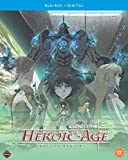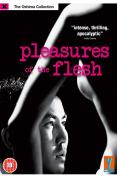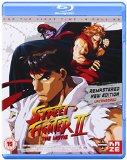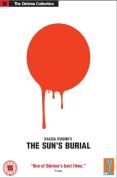![The Eel [Blu-ray] [Region A & B]](/pictures/1167693.jpg) The Eel | Blu Ray | (24/03/2025)
from £15.99
| Saving you £N/A (N/A%)
| RRP
The Eel | Blu Ray | (24/03/2025)
from £15.99
| Saving you £N/A (N/A%)
| RRP LIMITED EDITION BLU-RAY FEATURES High-Definition digital transfer Uncompressed mono PCM audio Interview with critic Tony Rayns (2024) Interview with screenwriter Daisuke Tengan (2024) Visual essay by Tom Mes on the year 1997 as a turning point in Japanese cinema (2024) Trailer Newly improved English subtitle translation Reversible sleeve featuring original and newly commissioned artwork by Time Tomorrow Limited edition booklet featuring a newly translated archival interview with Imamura Limited edition of 3000 copies, presented in full-height Scanavo packaging with removable OBI strip leaving packaging free of certificates and markings
![Taxi 2 [2001]](/pictures/1002667.jpg) Taxi 2 | DVD | (14/04/2003)
from £4.96
| Saving you £1.03 (20.77%)
| RRP
Taxi 2 | DVD | (14/04/2003)
from £4.96
| Saving you £1.03 (20.77%)
| RRP This action caper, once again written and produced by Luc Besson (who directed "The Fifth Element"), is a follow up to the 1998 original, and follows a demon taxi driver who helps the polic rescue a kidnapped ambassador.
 Heroic Age: The Complete Series - Blu-ray | Blu Ray | (22/06/2020)
from £14.20
| Saving you £N/A (N/A%)
| RRP
Heroic Age: The Complete Series - Blu-ray | Blu Ray | (22/06/2020)
from £14.20
| Saving you £N/A (N/A%)
| RRP This Heroic Age Complete Series set contains episodes 1-26. Long ago, the advanced Tribe of Gold vanished from the vast universe. In the void left by their departure, the tyrannical Tribe of Silver ascended to rule, forcing mankind - the Iron Tribe - to the brink of extinction. Now humanity wanders the cosmos in search of a savior. Prophesy has foretold of one who will labor for their freedoms, and on a planet of ruin, a champion is found. A feral boy named Age holds the destiny of their species in his hands and the untold power of the Tribe of Hero within. Special Features: Textless Songs, Trailers. Spoken Languages: English, Japanese, English subtitles.
![Princess Resurrection Complete Series Collection [DVD]](/pictures/1116775.jpg) Princess Resurrection Complete Series Collection | DVD | (10/09/2012)
from £9.97
| Saving you £40.02 (401.40%)
| RRP
Princess Resurrection Complete Series Collection | DVD | (10/09/2012)
from £9.97
| Saving you £40.02 (401.40%)
| RRP Since Hiro Hiyorimi's parents died, he and his sister Sawawa have lived apart. Now, Sawawa has gotten a new job as the caretaker of a creepy old mansion, and has sent Hiro a letter asking him to come and stay there with her. Finding the mansion boarded up and apparently empty, Hiro wanders around town looking for Sawawa. Instead, he runs into the new resident of the mansion, and ends up pushing her out of the way of some falling steel beams. Unfortunately, he loses his own life in the process. Luckily, or perhaps unluckily, the person he thought he saved turns out to be a princess of the monster kingdom, and she grants him a second life...but only for as long as he will be her servant.
![Akio Jissoji: The Buddhist Trilogy [Blu-ray]](/pictures/1146895.jpg) Akio Jissoji: The Buddhist Trilogy | Blu Ray | (19/08/2019)
from £29.99
| Saving you £N/A (N/A%)
| RRP
Akio Jissoji: The Buddhist Trilogy | Blu Ray | (19/08/2019)
from £29.99
| Saving you £N/A (N/A%)
| RRP Akio Jissôji created a rich and diverse body of work during his five decades in Japan s film and television industries. For some, he is best-known for his science-fiction: the 1960s TV series Ultraman and 1998 s box-office success Tokyo: The Last Megalopolis. For others, it is his 1990s adaptations of horror and mystery novelist Edogawa Rampo, such as Watcher in the Attic and Murder on D Street. And then there are his New Wave films for the Art Theatre Guild, three of which This Transient Life, Mandara and Poem, forming The Buddhist Trilogy are collected here. Winner of the Golden Leopard award at the 1970 Locarno Film Festival, This Transient Life is among the Art Theatre Guild s most successful and most controversial productions. The film concerns a brother and sister from a rich family who defy the expectations placed on them: he has little interest in further education or his father s business, instead obsessing over Buddhist statues; she continually refuses a string of suitors and the prospect of marriage. Their closeness, and isolation, gives way to an incestuous relationship which, in turn, breeds disaster. Mandara, Jissôji s first colour feature, maintained the controversial subject matter, focussing on a cult who recruit through rape and hope to achieve true ecstasy through sexual release. Shot, as with all of Jissôji s Art Theatre Guild works, in a radically stylised manner, the film sits somewhere between the pinku genre and the fiercely experimental approach of his Japanese New Wave contemporaries. The final entry in the trilogy, Poem, returns to black and white and is centred on the austere existence of a young houseboy who becomes helplessly embroiled in the schemes of two brothers. Written by Toshirô Ishidô (screenwriter of Nagisa Ãshima s The Sun s Burial and Shôhei Imamura s Black Rain), who also penned This Transient Life and Mandala, Poem continues the trilogy s exploration of faith in a post-industrial world. LIMITED EDITION CONTENTS High Definition Blu-ray (1080p) presentations of This Transient Life, Mandara and Poem Original uncompressed LPCM mono 1.0 audio on all three films Newly translated optional English subtitles Introductions to all three films by David Desser, author of Eros Plus Massacre: An Introduction to the Japanese New Wave Scene-select commentaries on all three films by Desser Theatrical trailer for Mandara Theatrical trailer for Poem Limited edition packaging, fully illustrated by maarko phntm Illustrated 80-page perfect-bound collector s book featuring new writings on the film by Anton Bitel and Tom Mes
![Kagemusha [1980]](/pictures/1003309.jpg) Kagemusha | DVD | (03/06/2002)
from £6.99
| Saving you £6.00 (85.84%)
| RRP
Kagemusha | DVD | (03/06/2002)
from £6.99
| Saving you £6.00 (85.84%)
| RRP The 1970s were difficult years for the great Japanese director Akira Kurosawa. Having been unable to secure full Japanese backing for his epic project Kagemusha, the 70-year-old master found American support from George Lucas and Francis Ford Coppola, who served as co-executive producers (through 20th Century Fox) for this magnificent 1980 production--to that date the most expensive film in Japanese history. Set in the late-16th century, Kagemusha centres on the Takeda clan, one of three warlord clans battling for control of Japan at the end of the feudal period. When their leader Lord Shingen (Tatsuya Nakadai) is mortally wounded in battle, he orders that his death be kept secret and that his "kagemusha"--or "shadow warrior"--take his place for a period of three years to prevent clan disruption and enemy takeover. The identical double is a petty thief (also played by Nakadai) spared from execution due to his uncanny resemblance to Lord Shingen--but his true identity cannot prevent the tides of fate from rising over the Takeda clan in a climactic scene of battlefield devastation. Through stunning visuals and meticulous attention to every physical and stylistic detail, Kurosawa made a film that restored his status as Japan's greatest filmmaker, and the success of Kagemusha enabled the director to make his 1985 masterpiece, Ran. --Jeff Shannon
![Street Fighter 2 - The Movie [1994]](/pictures/1003674.jpg) Street Fighter 2 - The Movie | DVD | (29/10/2001)
from £49.99
| Saving you £-27.00 (N/A%)
| RRP
Street Fighter 2 - The Movie | DVD | (29/10/2001)
from £49.99
| Saving you £-27.00 (N/A%)
| RRP In the not so distant future civilisation is under attack. Leading the forces of darkness is the evil mastermind Bison who is determined to capture the minds and bodies of the world's greatest fighters for use in his manic plan to conquer the world. The only people on Earth with the potential to stop him are Ken and Ryu two powerful legendary martial arts warriors. Together they face the fight to end all fights. The final battle of good against evil is about to begin!
![Drunken Angel [1948]](/pictures/1010992.jpg) Drunken Angel | DVD | (25/07/2005)
from £13.99
| Saving you £6.00 (42.89%)
| RRP
Drunken Angel | DVD | (25/07/2005)
from £13.99
| Saving you £6.00 (42.89%)
| RRP Post-war Japan anatomised in the combative relationship between an alcoholic doctor (Takeshi Shimura) and his patient (Toshiro Mifune) a wounded young gangster. This is the film that was considered to be Kurosawa's breakthrough movie illuminating themes that would go on to dominate his succeeding work. 'Drunken Angel' also marked his first - of many - collaborations with Toshiro Mifune here playing the tubercular Yakuza hoodlum.
 Pleasures Of The Flesh | DVD | (08/09/2008)
from £N/A
| Saving you £N/A (N/A%)
| RRP
Pleasures Of The Flesh | DVD | (08/09/2008)
from £N/A
| Saving you £N/A (N/A%)
| RRP Katsuo Nakamura stars as a man blackmailed by a thief who makes him hold on to some stolen loot while the thief serves a jail sentence. Nakamura is led into temptation by all that money sitting around so he decides to spend it on wild partying and sex before killing himself to avoid retribution.
![Dark Water [2003]](/pictures/1022067.jpg) Dark Water | DVD | (24/11/2003)
from £5.99
| Saving you £9.00 (150.25%)
| RRP
Dark Water | DVD | (24/11/2003)
from £5.99
| Saving you £9.00 (150.25%)
| RRP From the director and producer of the original Japanese world-wide horror hit 'Ringu' ('The Ring') comes another spine-tingling scare.
![Sanjuro [1962]](/pictures/1002186.jpg) Sanjuro | DVD | (06/10/2003)
from £12.99
| Saving you £7.00 (53.89%)
| RRP
Sanjuro | DVD | (06/10/2003)
from £12.99
| Saving you £7.00 (53.89%)
| RRP Sequel to Kurosawa's own 'Yojimbo' in which the crafty samurai helps a young man and his fellow clansmen save his uncle who has been framed and imprisoned by a corrupt superintendent...
 Street Fighter II: The Movie Blu-ray | Blu Ray | (13/05/2013)
from £N/A
| Saving you £N/A (N/A%)
| RRP
Street Fighter II: The Movie Blu-ray | Blu Ray | (13/05/2013)
from £N/A
| Saving you £N/A (N/A%)
| RRP Shadowlaw - an underground organization bent on world domination through drug smuggling illegal weapons distribution and terrorism. Led by the evil M. Bison (Vega in the Japanese version) Shadowlaw hopes to increase their power by recruiting the world's greatest street fighters. Their main target: Ryu - a master of Shotokan Karate who roams all over the world to test his skills against other fighters. As a means to lure the elusive Ryu Bison abducts his best friend former martial art champion Ken Masters and uses him as bait. Interpol agent Chun-Li and U.S. Air Force pilot Guile team up to get to Ryu before Bison does and continues his reign of terror.
 The Sun's Burial | DVD | (26/05/2008)
from £N/A
| Saving you £N/A (N/A%)
| RRP
The Sun's Burial | DVD | (26/05/2008)
from £N/A
| Saving you £N/A (N/A%)
| RRP Set in the post-war slums of Osaka The Sun's Burial follows the lives and fates of the denizens of this hellish ghetto. Pimps prostitutes drug addicts vagrants hustlers and gangsters struggle to survive amidst the poverty and decay of 1950's Japan. Unflinching in it's portrayal of life in these slums the film goes beyond a documentary-style realism to achieve a garish lurid Cinemascope aesthetic that is at once repulsive and yet mesmerising. It's a pitiless and dispassionate portrait of a living hell that lurks behind the facade of a prosperous new Japan a place where everything - food sex even blood - is simply a commodity to be stolen and sold.
![D. Gray Man - The Complete Collection [DVD]](/pictures/1102598.jpg) D. Gray Man - The Complete Collection | DVD | (06/12/2010)
from £15.19
| Saving you £44.80 (294.93%)
| RRP
D. Gray Man - The Complete Collection | DVD | (06/12/2010)
from £15.19
| Saving you £44.80 (294.93%)
| RRP Valiant demon-hunter Allen Walker and his comrades remain steadfast in their quest to recover the lost Innocence while slaying the undead minions of evil's most terrifying army. When the treacherous Millennium Earl senses a shift in the balance of power the wicked leader of the Akuma summons forth a band of rogue warriors who will shake the Black Order to its very core. The battle to decide the fate of mankind has begun. Should Walker fail Innocence will be lost forever.
![Returner [2002]](/pictures/1029125.jpg) Returner | DVD | (19/01/2004)
from £6.73
| Saving you £13.26 (197.03%)
| RRP
Returner | DVD | (19/01/2004)
from £6.73
| Saving you £13.26 (197.03%)
| RRP The future could be history! Eighty years in the future time is running out on mankind. The only hope rests with a brave time traveller who must return to the past to change history...and alter Earth's destiny. 2084. After decades of intense fighting an alien invasion force is close to destroying what's left of the world. In a last-ditch effort to save the human race a guerrilla fighter named Miri leaps into a waiting Time Shifter. With the Alien Wars set to begin in 72 hours s
 Heroic Age: The Complete Series - DVD | DVD | (22/06/2020)
from £10.75
| Saving you £N/A (N/A%)
| RRP
Heroic Age: The Complete Series - DVD | DVD | (22/06/2020)
from £10.75
| Saving you £N/A (N/A%)
| RRP This Heroic Age Complete Series set contains episodes 1-26. Long ago, the advanced Tribe of Gold vanished from the vast universe. In the void left by their departure, the tyrannical Tribe of Silver ascended to rule, forcing mankind - the Iron Tribe - to the brink of extinction. Now humanity wanders the cosmos in search of a savior. Prophesy has foretold of one who will labor for their freedoms, and on a planet of ruin, a champion is found. A feral boy named Age holds the destiny of their species in his hands and the untold power of the Tribe of Hero within.
 Scandal | DVD | (14/11/2005)
from £5.54
| Saving you £14.45 (72.30%)
| RRP
Scandal | DVD | (14/11/2005)
from £5.54
| Saving you £14.45 (72.30%)
| RRP On holiday in the snow-covered mountains young painter Ichiro Aoye (Toshiro Mifune) has a chance meeting with the popular singer Miyako Saijo (Shirley Yamaguchi). After giving her a ride back to the hotel where they are both staying Ichiro is photographed with Miyako by paparazzi. A magazine creates an expos of their 'secret romance' based around this photograph and the brooding Ichiro ignites a bitter and dirty libel case in order to restore their honour... Akira Kurosawa's
![The Life Of Oharu [1952]](/pictures/1011920.jpg) The Life Of Oharu | DVD | (26/04/2004)
from £N/A
| Saving you £N/A (N/A%)
| RRP
The Life Of Oharu | DVD | (26/04/2004)
from £N/A
| Saving you £N/A (N/A%)
| RRP Mizoguchi reckoned The Life of Oharu was his masterpiece, and who are we to disagree? Certainly it's among his most perfectly structured films, in which anger at the treatment of women in Japanese society is balanced by the director's flawless sense of period, and by expert pacing and visual composition. The story is set in the 17th century, when Japan had settled into a rigidly hierarchical society. Kinuyo Tanaka, in perhaps the finest role of her career, plays Oharu, a highborn woman of the Imperial court. Disgraced when she falls in love with a man of a lower class (Toshiro Mifune, in his only film for Mizoguchi), she's made the mistress of a feudal lord. After bearing him a son she's cast out, and gradually sinks into prostitution and penury. The inevitability of Oharu's fate is tempered by her resilience of spirit--and by the compassion of Mizoguchi's gaze. Although the story is set in the past, he fully intends parallels with modern-day Japan; just after completing the film, he told an interviewer, "Comparing today with [earlier] periods, I don't find much difference: women have always been treated like slaves." The Life of Oharu was shown at the 1952 Venice Festival, where it was awarded the Golden Lion. It brought Mizoguchi a belated international fame just four years before his death, and initiated the run of late masterpieces that rounded off his career. --Philip Kemp
![Sansho Dayu [Masters of Cinema] (Dual Format Edition) [Blu-ray]](/pictures/1113980.jpg) Sansho Dayu | Blu Ray | (23/04/2012)
from £N/A
| Saving you £N/A (N/A%)
| RRP
Sansho Dayu | Blu Ray | (23/04/2012)
from £N/A
| Saving you £N/A (N/A%)
| RRP Based on an ancient legend, as recounted by celebrated author Mori Ogai (in his short story of the same name, written in 1915), and adapted by Mizoguchi, Sansho Dayu [Sansho the Steward, aka Sansho the Bailiff] is both distinctively Japanese and as deeply affecting as a Greek tragedy. Described in its opening title as one of the oldest and most tragic in Japan's history, Mizoguchi depicts an unforgettably sad story of social injustice, family love, and personal sacrifice - all conveyed with exquisite tone and purity of emotion. Set in Heian era (11th century) Japan, it follows an aristocratic woman, Tamaki (played by Tanaka Kinuyo, who also stars in Mizoguchi's Ugetsu Monogatari), and her two children, Zushio (Hanayagi Yoshiaki) and Anju (Kagawa Kyoko), who are separated by feudal tyranny from Tamaki's husband. When the children are kidnapped and sold into slavery to the eponymous Sansho (Shindo Eitaro), the lives of each of the family members follow very different paths - each course uniquely, and insufferably, tragic. Famed for its period reconstructions and powerful imagery, often through the director's trademark long takes, Sansho Dayu is one of the most critically revered of all of japanese cinema - a Venice Film Festival Silver Lion winner that often appears in lists of the greatest films ever made.
![Rain Fall [DVD]](/pictures/1098034.jpg) Rain Fall | DVD | (29/03/2010)
from £4.98
| Saving you £13.00 (434.78%)
| RRP
Rain Fall | DVD | (29/03/2010)
from £4.98
| Saving you £13.00 (434.78%)
| RRP Rain Fall

Please wait. Loading...
This site uses cookies.
More details in our privacy policy